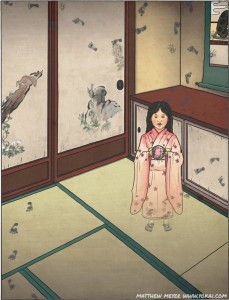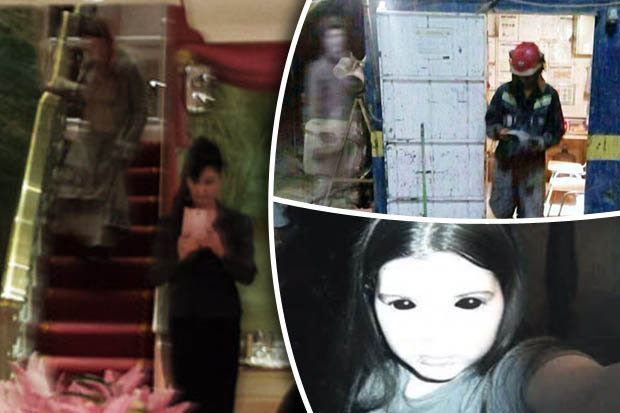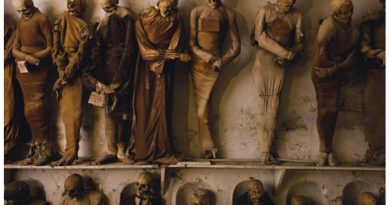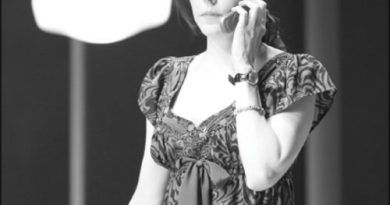Zashiki Warashi – The Lucky Child Spirit
Zashiki warashi are house spirits, fond of mischief, loved by all, and believed to bring great fortune and riches to those whose houses it haunts. They appear as ghost-like five or six year old children with blushing red faces. They can be boys or girls, and usually wear tradition clothes; child-sized warrior costumes for boys, patterned kimonos, with short, bobbed, or long, tied back hair for girls. Rarely they appear as wild, hairy brutish figures. Often it is difficult to make out any details other than a vague child-like shape. Direct sightings of these ghosts are rare. In some instances it is said that only the houses owners, or only children, are able to see these spirits. Because of this, they are usually known only by their pranks.
The definition of “yokai” or “youkai” is anything that is under the category of paranormal beings in Japanese mythology. The idea of a yokai cannot be pinned down to a specific creature. It can be anything from an entity to an enigma. If you were to translate the word “yokai”, you would get English words such as “bewitching”, ‘suspicious”, “attractive”, and “specter”. They’re not all evil, and they’re not all mischievous – but the Zashiki Warashi is one of them.
The zashiki warashi is also sometimes referred to as “Zashiki Bokko”, which means “guestroom basker”. The idea of zashiki-warashi is that it is a spirit that resides in guest or storage rooms in the form of a child of either gender. Some would refer to them as gods, thus the label of “child”.
Generally the beings have a red face, hair that hangs down, and the appearance of that of a five- or six-year-old child, but, depending on the house that they settle in, age range reports range from a minimum of around three years and a maximum of around 15 years. They have a bob haircut or very short cropped hair. Both males and females have been seen, and the male ones are said to wear blackish clothes with a kasuri or striped pattern, and the females are said to wear a red chanchanko, kosode, and sometimes a furisode. It is also said that there are some whose appearance is unclear, making their gender unknown. Sometimes multiple beings would settle in a house at once, such as a boy and a girl. There are also some legends telling of ones that look like a black beast, and others that look like a warrior.
By the end of November 2015, a mirrored website offered video footage from a home video camera in Japan. It captured the image of what appears to be a girl wearing a kimono walking in the house. Her body is translucent and can walk through walls. It is believed that she was a zashiki-warashi
They like causing mischief, so they are said to leave ash or bleaching powder on top of little footprints and at nighttime, they are said to make sounds like that of a revolving spinning wheel, and they would also make sounds in an inner room making sounds like that of a kagura performance. There are also tales told about how when someone in the family is sewing alone, there would be sounds similar to the rustling of papers or someone snorting, and when the wooden door is opened there would be no one there. It is also said that at night, they would do pranks such as riding on top of guest room futons and turning over the pillows in order to not let the person sleep, and when attempts are made to stop it, it would be too strong and powerful for anyone to even affect its actions. Sometimes they also play with children.
In Iwate, there are legends of how the zashiki-warashi of a shrine at Hayachine would follow a shrine visitor who came from afar and follow them into different lands. There are also legends of how the zashiki-warashi would teach the nursery rhyme of Iwate to the children of those lands.
In Gonohe, Aomori Prefecture, there is a legend of how when a new house is built, a zashiki-warashi can be called into it by burying a golden ball under the floors.
There are theories about how they cannot be seen by anyone other than members of the family or how they can only be seen by children but not adults. There are stories about how when adults counted children, there would be one more person than there was originally, but as adults do not understand what zashiki-warashi are, they would not know who is the extra person. Stories like these frequently appear as themes in literature.
The zashiki warashi can be anywhere from 3 to 15 years old, but most of them seem to look around 5 or 6. Their faces are distinctly red from blushing, perhaps because of the mischief they have caused, or are about to cause. Sightings of a zashiki warashi are uncommon, but they appear in big, old houses that still have people living in them. Only a few people can really see them; supposedly only either the owners of the house they haunt or their children can do so. Because of this, they are known for the mischief they cause more than their visual appearance.
According to folklore, to attract and maintain a zashiki warashi in the home it is said that “the spirit must be noticed, appreciated and cared for properly, much in the manner one would raise a child, though too much attention may drive it off.” As the zashiki warashi is child-like in nature, it is prone to playing harmless pranks and occasionally causing mischief. They might, for instance, “sit on a guest’s futon, turn people’s pillows over or cause sounds similar to kagura music to be heard from rooms no one uses.” Sometimes they leave little footsteps in ashes. There are different variations as to who can see the zashiki warashi; usually this is limited to inhabitants of the house, sometimes to children.

There are characteristics to look out for to be able to identify it as a zashikiwarashi. If the zashiki warashi is a girl, you’ll see it sport a kimono (Japanese outfit for a woman) such as a “furisode”, or a Japanese robe called “kosode”. The clothes of male zashiki warashi tend to veer to more patterned outfits, such as striped fabrics or patterns of assorted design like “kasuri”. Both genders have similar hairstyles; usually, straight hair chopped to a bob cut, which makes it hard to tell what kind of zashiki warashi is inhabiting that room, though occasionally some zashiki warashi girls possess long hair that is brushed back and tied.
Then again, stories of zashiki warashi vary widely. Some stories recount instances of having two or more of them in the same place at once. Others demonize the look of the zashiki warashi, claiming it to resemble a black, brute beast, while some male zashiki warashi boys are said to don warrior clothing. These are rarer counts, though, compared to the usual witnesses of an innocent child.
If you have a fireplace, and suddenly see children’s footprints on the floor of those ashes (and you’re sure they’re not your dog’s or anyone else’s), you could be almost certain that is a zashiki warashi playing a prank on you. They do the same, even with other substances such as powdered bleach. The laughter that comes from a child or children, the sound of paper being crumpled, snorting, kagura music, the creak of an opening door made of wood, and the sound of whirring gears of a turning wheel are audible signs you have a zashiki warashi in your house.
If the pillows of your bed are all in disarray, and you can see that someone has been playing or riding your beloved futon, then that is a tell-tale diagnosis for a zashiki warashi haunting. Because of their childlike nature, they want to play and be noticed as much as possible by those living on the premises. They’d do anything to just be normal kids; such as have fun and play games – especially with other children.
Kizen Sasaki noted that perhaps they are the spirits of children who were crushed to death and buried at the home. In the Tōhoku region, infanticide was called usugoro (臼殺, or “mortar kill”), and it is said that children who were killed this way to reduce the number of mouths to feed would be killed by being crushed by a stone mortar and there was a custom of burying them in the dirt floor room (doma) or in the kitchen. It is said that the spirits of such children would on rainy days walk around outer edges shaking and frightening the guests, which is said to be seen to resemble deeds similar to that of a zashiki-warashi. The aforementioned notabariko and usu-tsuki warashi are seen to be lower ranking among the zashiki-warashi, and the former would peek out from the inner dirt floor (doma) room and crawl around while the latter would use a mortar to make a sound. Due to such acts, it is sometimes suggested that these kinds of zashiki-warashi have a relation to the fact that the location where the infantide happened is in the dirt floor (doma) room or underneath a mortar.
In addition to this relation to infanticide, the fact that the zashiki-warashi are in both old homes and are often mentioned in relation to legends about how after a visiting Buddhist pilgrim from outside the village was killed, the family of the home came to ruin, it has been suggested that these zashiki-warashi are signs of the dark undersides of the village’s community.
In the “Zashiki-warashi wo Mita Hitobito” (座敷わらしを見た人びと, “The People Who Saw Zashiki-Warashi”) by the author Sadako Takahashi, there are also stories about zashiki-warashi that came about from a curse that resulted from carpenters and tatami makers that were unable to do their construction jobs in comfort, and it is said that there were rituals of taking a doll that had a bit of its wood peeled off and inserting it between the pillars and beams.
There are also many theories that their true identity is that of a kappa, and there are stories of a zashiki-warashi being a kappa that lived in the depths who would rise up and go into a nearby home to do pranks, as well as stories of zashiki-warashi that were kappa that have settled into a home.
Concerning why zashiki-warashi look like children, seeing how in Buddhism there are gōhō-warashi (wrathful gods that protect Buddhism and take on the appearance of a child), there is the theory that they come from folk beliefs in how children connected gods and humans, as well as the theory that the appearance of a child embodies divinity.
In Kunio Yanagita’s view, just as the gōhō-warashi were called forth from the heavens by high priests, the protective spirits of Buddhism and folk mikos are related to the faith in giving respect to the freshness of the spirits of young leaves, and this is related to the faith in the zashiki-warashi who became protective spirits of a home in order to will divinity to humans. In folkloristics, after Yanagita also, there has been debate on subjects such as the relation to Okunai-sama and the relation of children that come from another realm such as the Ryūgyū-warashi (dragon palace warashi).
Also, the folklorist Kazuhiko Komatsu views warashi (children) from the point of view of cultural anthropology, and regarding the question of the fortune within homes and the movement of wealth within a village, he notes that zashiki-warashi have almost all their characteristics in common with animal spirit possession such as izuna-tsukai (“weasel-using”). From an analysis of the supremacy and inferiority within the community of families with a spirit haunting them, he notes that zashiki-warashi have been used as a basis for explaining changes in fortunes within folk society, especially for old homes and families.
In Ueda Akinari’s late Edo-period yomihon the Ugetsu Monogatari, in the story “Hinpuku-ron” (Theory of Wealth and Poverty), in Mutsu Province (now Aomori Prefecture), in a certain home of a warrior family, a spirit of money appears in the form of an old man going by the name of “Ōgon no Seirei” (“golden spirit”) who said “I’m glad you treat money as something important to you, so I came to tell a story”, but the doctor of letters Masamichi Abe suggests that perhaps this is an older, more prototypical type of zashiki-warashi.
Source: WikiPedia



